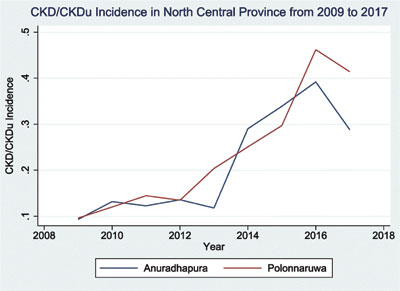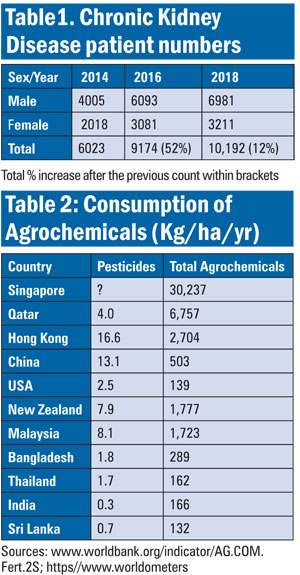Sunday Times 2
Agrochemical issue: Local Lysenko misleading President and people
 Trofim Lysenko(1898-1976), projecting himself as a star proletarian scientist, and realizing that print and social media could fuel his rise to the top of the Soviet society, made a name for himself by publishing myths in the media.
Trofim Lysenko(1898-1976), projecting himself as a star proletarian scientist, and realizing that print and social media could fuel his rise to the top of the Soviet society, made a name for himself by publishing myths in the media.
In the 1930s, Lysenko advanced a “theory of nutrients” to explain plant development and totally rejected Mendelian genetic theories accepted and proven by then across the world. Lysenko claimed that Mendelian genetics was contrary to Marx’s theory of “historical materialism” and the Marxist dialectical view of how nature evolves. He reportedly faked much of his results, and became one of the most distinguished figures in agronomy and plant biology in Russia. Stalin put him in charge of Soviet agriculture. He loathed genetics and claimed that it is only the environment that determined crop growth and yield.
In the 1920s and early 1930s, Joseph Stalin with Lysenko’s backing instituted a catastrophic programme to modernise Soviet agriculture, just like our overnight organic farming policy drive backed by our local Lysenko! The Soviet agriculture modernisation programme was, however, led to crop failure, hunger and famine killing at least seven million people. But Stalin refused to change course.
A Soviet scientist in later years remarked that “To talk genetics to Lysenko was like trying to explain differential calculus to a man who did not know his 12-times table.”
Mao Zedong’s Communist China adopted the Soviet methods in the late 1950s and endured even a bigger famine. Peasants were made to eat leaves, tree bark and bird droppings! Would our hurried organic agriculture drive lead to a similar calamity?
In Sri Lanka, too,several local ‘replicas’ are misleading the political authority and the people! One of them misled the former president claiming that the weed killer glyphosate was the aetiolating agent of the Rajarata kidney disease, and got the chemical banned, but later the ban had to be lifted for tea with Japan refusing to buy Sri Lankan tea as it had residues of the alternative weed killer, MCPA, that was used!
Unlike the Russian one, the local Lysenko is a highly qualified and reputed medical practitioner and president of a leading medical officers’ union. The union has been rightly critical of mistakes of the health authorities, but its leader seldom appears at media briefings for obvious reasons! As per the grapevine, he is eying a health portfolio or at least a top post in the sector!
He appears to be the unofficial chief advisor to the President on his mission to convert the entire country to organic agriculture within one season. The main contention for this is purported to be that agrochemicals are the main cause of many non-communicable diseases, especially the chronic kidney disease (CKD). Whilst there is no evidence to implicate that agrochemicals are the causal agent of it, the available evidence strongly points to the fact that hard water in conjunction with fluoride released from the Regolith aquifers are the causal agents of the disease. Reportedly, there are some 176,000 such wells in the Rajarata.
 Hard water, fluoride and CKD
Hard water, fluoride and CKD
A study compared two adjacent villages in Girandurukotte — Ginnoruwa on high ground where the people exclusively drank water from dug wells on high ground and Sarabhumi in the plain where the people drank water from the river, reservoir or wells dug close to their homes. Both groups ate rice grown in the plains of Sarabhumi. The Ginnoruwa people contacted the disease, but none from Sarabhumi. Analysis of the well water revealed that the Ginnoruwa water was hard and heavily contaminated with fluoride, a highly nephrotoxic chemical, but free from agrochemicals.
Further evidence for a role for fluoride in the disease is that CKD patients also often have dental fluorosis.
The research of at least five separate groups and their publications provide proof for this contention. One research group from the Peradeniya University fed Ginnoruwa well water and tap water from the laboratory to rats to compare the effects. The result was that the kidneys of the well-water fed rats were damaged but not those of the others.
The graph from a research paper in BMC Nephropathy Vol. 20 provides evidence that as people in the affected areas began drinking good water from the reservoirs, streams and wells dug in the plains and RO water, after the Ginnoruwa-Sarabhumi study and similar research, CKD incidence started declining rapidly. The Ginnoruwa households were provided plastic tanks for harvesting rainwater for drinking and other household use in 2014/5. Sadly, this study has not been followed up by the health authorities, but the information from residents is that the affected numbers in Ginnoruwa are declining.
The above findings are further confirmed by the Sentinel Surveillance data of the National Renal Unit reported as summarised in Table 1.
It is amply evident that with the message reaching the people that bad water is the cause of the disease, and people resorting to good drinking water, the number of CKD patients is showing a decline. The numbers decreased from 52% to 12%. (See Table 1). The 2019 Sentinel Surveillance data has apparently not been published yet. Regrettably, however, the Health Ministry, to my knowledge, has not publicly acknowledged that as per the evidence available hard water and fluoride are the causes of the disease!
Be that as it may, our local Lysenko would show only the graph’s bottom part to support his claim that there is an exponential rise in the CKD patient numbers with time, but carefully refrain from showing the top part which is clear evidence of the numbers declining with good drinking water. He, however, has always refrained from commenting on the impact of quality water on declining CKD numbers and continues to blame agrochemicals without evidence.
No link between agrochemicals and Rajarata CKD
The 2013 World Health Organisation study reported that CKDu patients secreting more cadmium and also some pesticide residues above reference (safe) limits. However, the report failed, for reasons unknown, to report the pesticide residue status of control (unaffected) subjects from Hambantota. Later, we were able to get the raw data of the entire study and re-analyse them Unexpectedly, the data revealed that the numbers of subjects with pesticide residues levels above reference limits were far higher in the control group!
Then in 2018, an international Consultation on the CKD was held in Sri Lanka with the participation of forty eight experts, local and foreign. Its report concluded that there was no evidence to implicate any agrochemicals in the causation of the disease.
Is Sri Lanka consuming the highest quantities of agrochemicals?
Further, our Lysenko on many occasions has claimed that Sri Lanka is consuming the highest levels of agrochemicals. The FAO and World Bank published data, as we have pointed out on numerous occasions, do not support his contention. According to such data (Table 2,) Sri Lanka is using the lowest amounts of fertiliser and pesticides per unit area in this part of the world! Further between 2002 and 2016, we have reduced the use of Class 1 (most toxic) pesticide by 98% and Class 2 by 29%. This is not to say that everything is ‘honkey dory!’ Instances of agrochemical misuse are not uncommon, and the government should address this as a matter of highest priority through education of farmers and strengthening our run-down extension service!
Going back to traditional varieties
Another pet subject of our local Lysenko is returning to traditional rice varieties and farming methods. Regrettably he does not seem to be aware that some of our new improved rice varieties such as Bw 364, At 353 and Bw 272-6b have comparable protein levels and glycemic indices as those of the traditional varieties and yields 2 to 3 times more! In any case the staple diet is essentially to provide the carbohydrates while other nutritional needs are usually obtained from fish, meat, vegetables and fruits. If we return to traditional varieties the national rice production would be halved.
Nobel Laureate Norman Borlaug, the Father of the Green Revolution, addressing the Nobel forum in 2000 remarked that if we were to go back to traditional varieties and other associated farming technologies, we will need three times more land than we farm now to feed the world. Imagine the environmental damage it could cause if that happens! He concluded that it is far wiser to continue with conventional agriculture correcting its shortcomings!
The need for a National Planning Commission
It is regrettable that the President is rushing into decisions without consulting experts in the relevant fields. Ideally he should have a viable planning commission of experts from different fields, as happens in India, for example, from the days of Jawaharlal Nehru (1950). The Planning Commission of India continues with the same mandate of advising on national policy matters but with the name changed to National Technology Commission(NITI Aayog) by Premier Narendra Modi who wanted to lay emphasis on technology- related matters. We too have had dysfunctional planning commissions, especially during the Yahapalana regime!
Needless to say that rushing into decisions such as the banning of oil palm and organic agriculture without consulting the relevant institutions and experts could have disastrous consequences!

